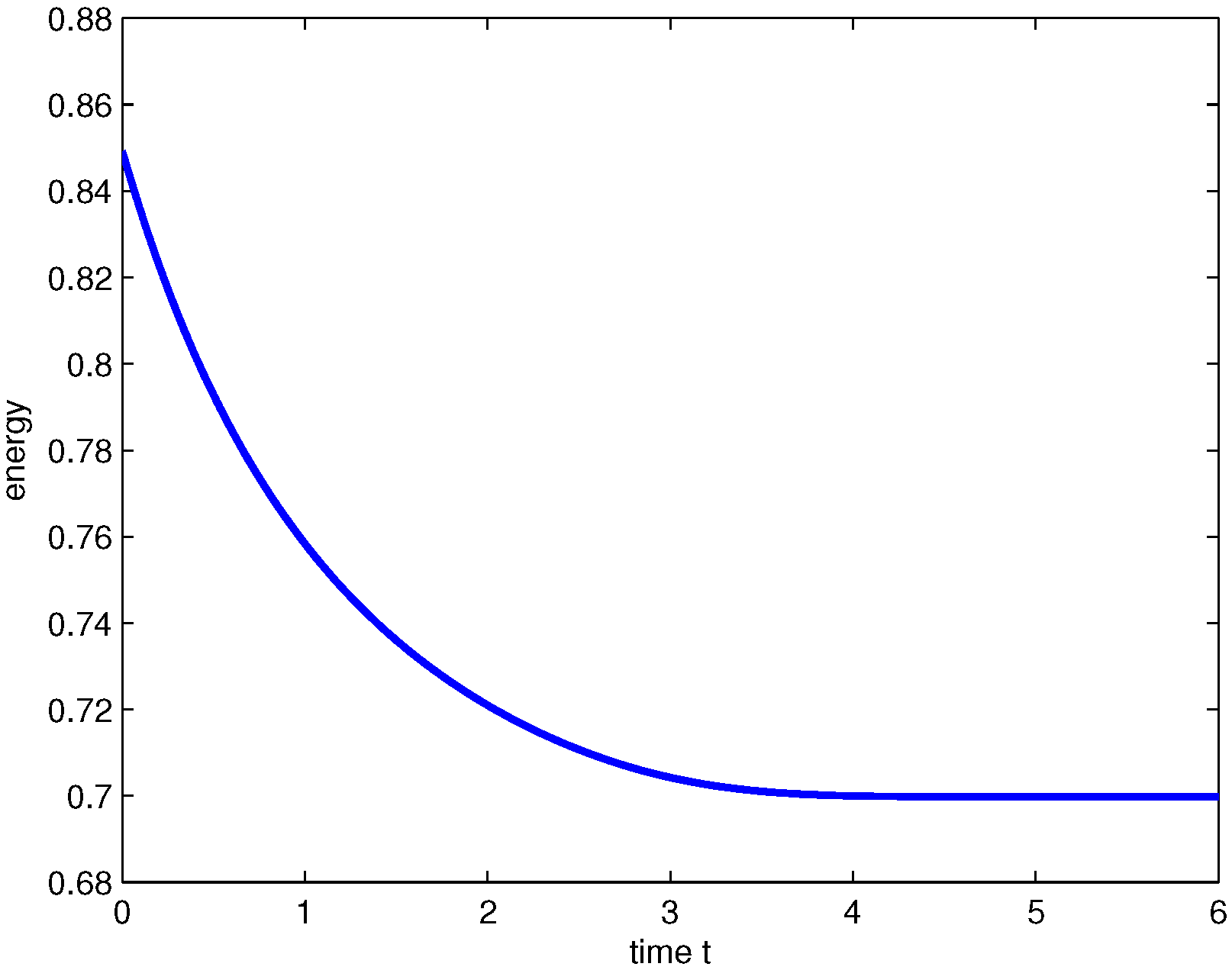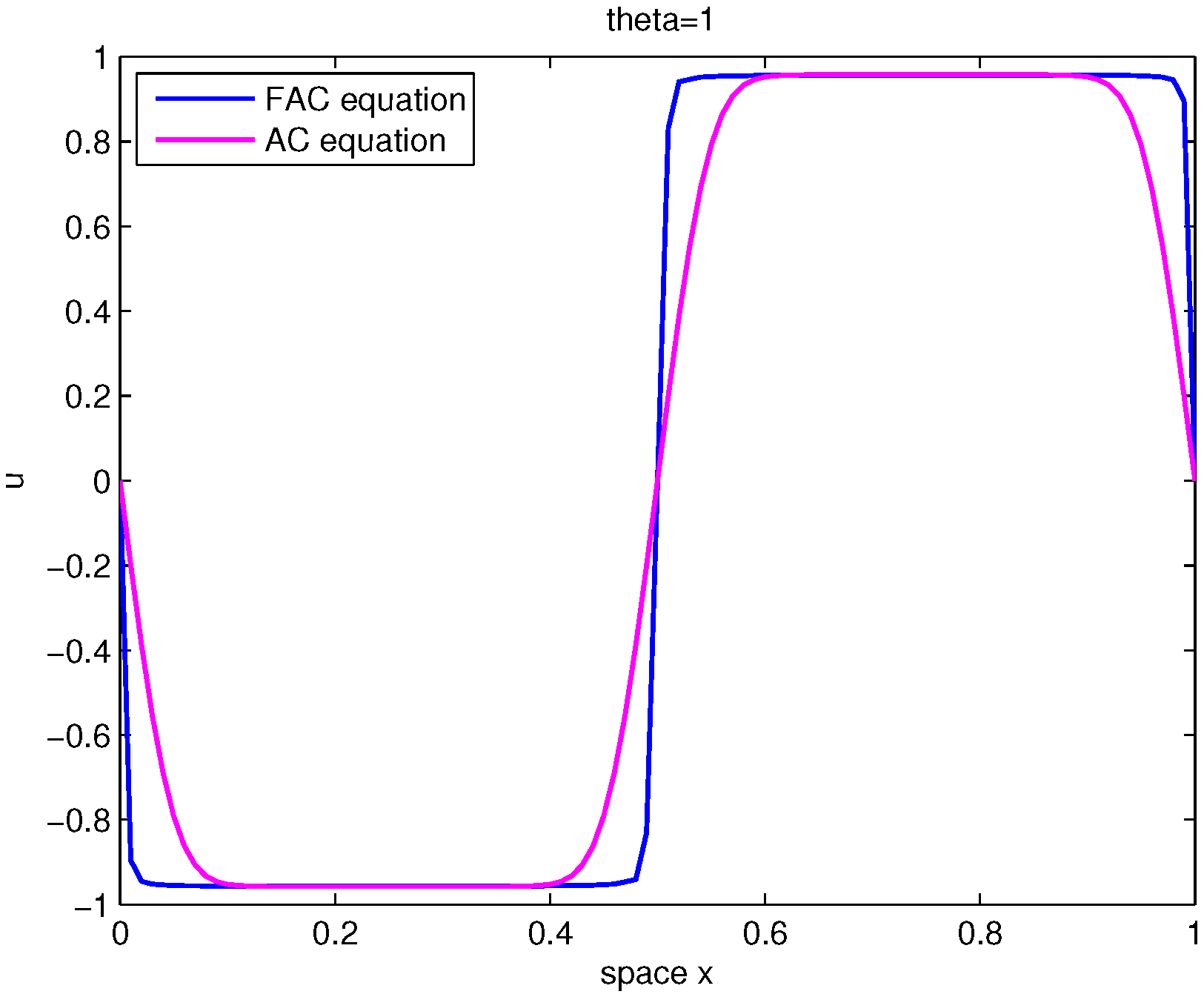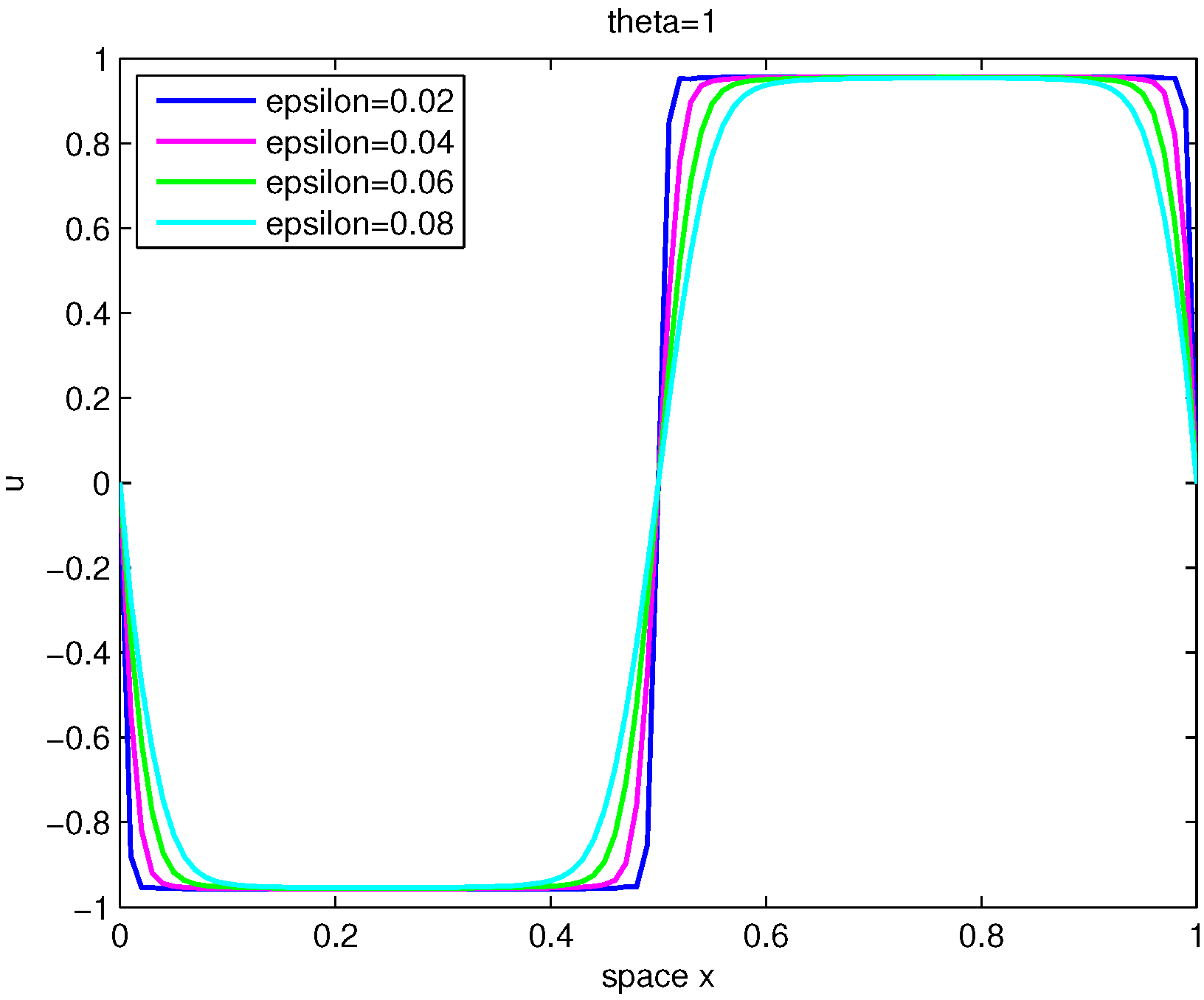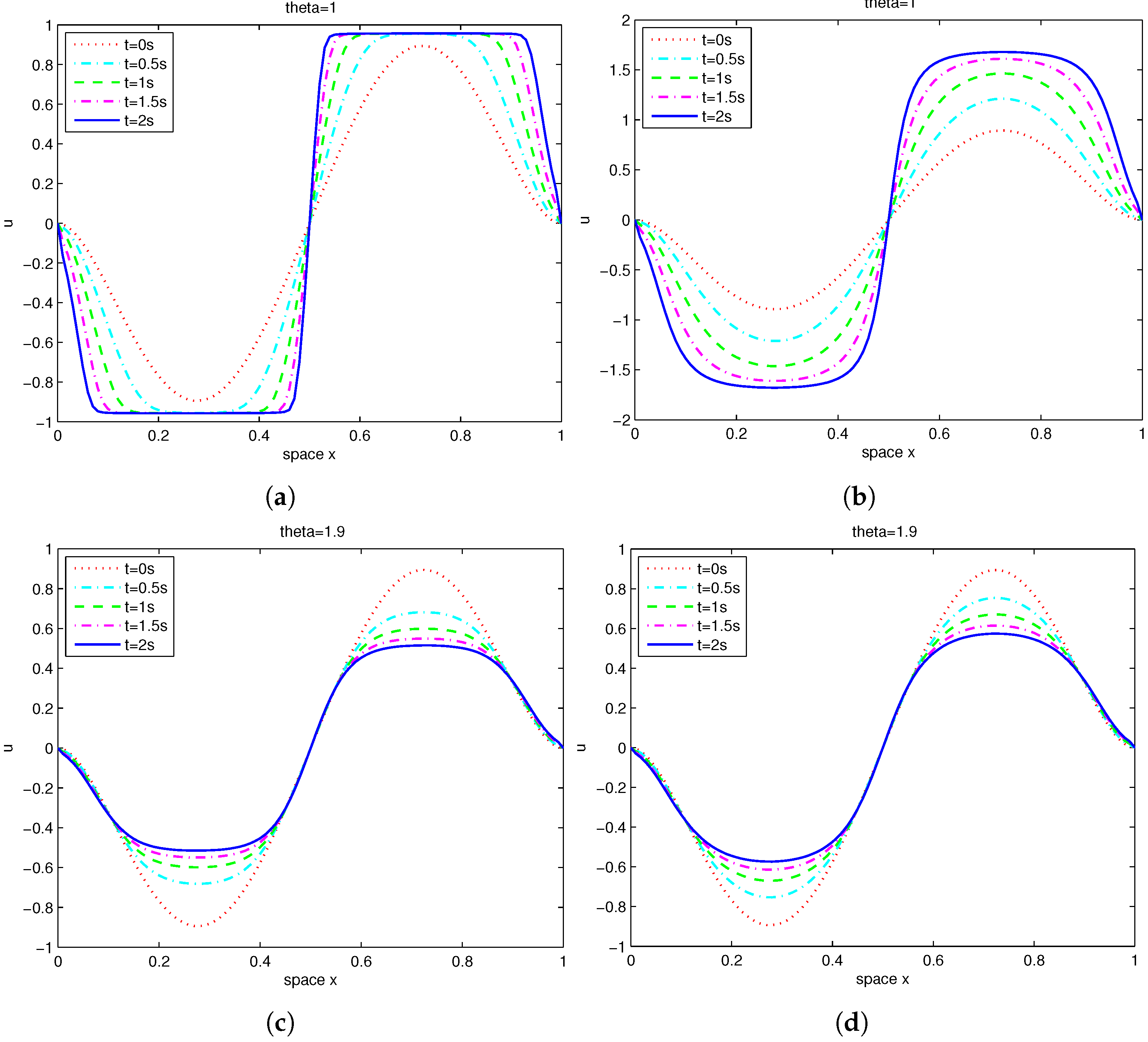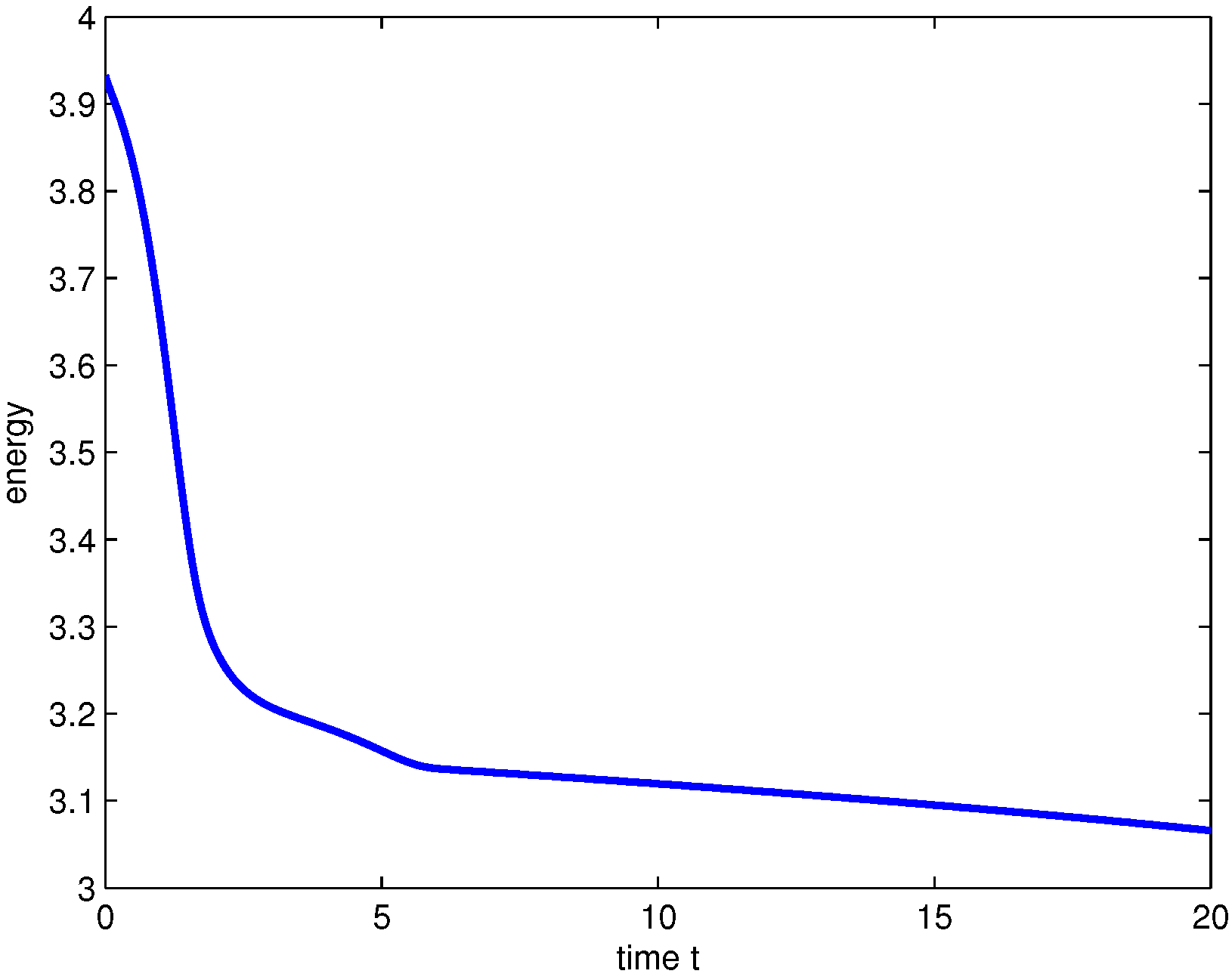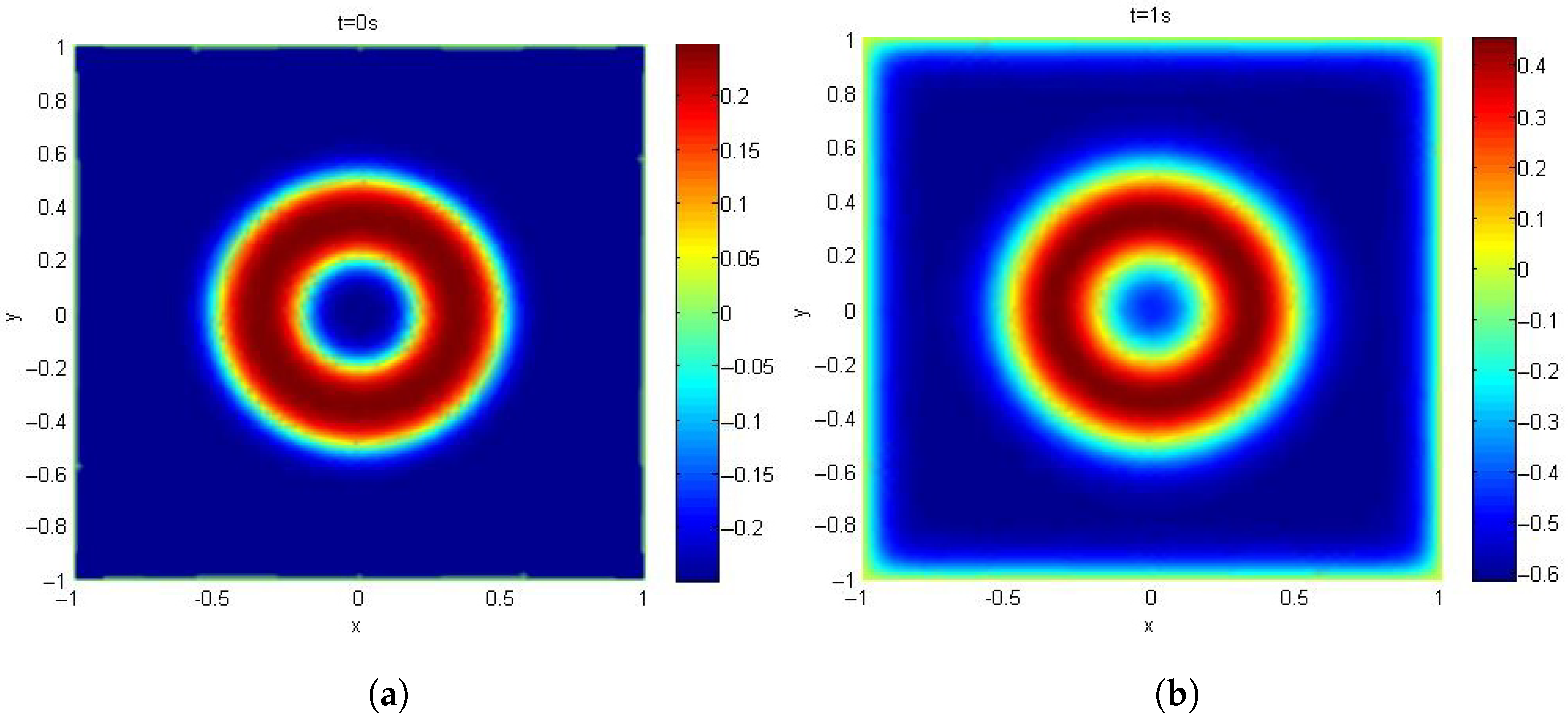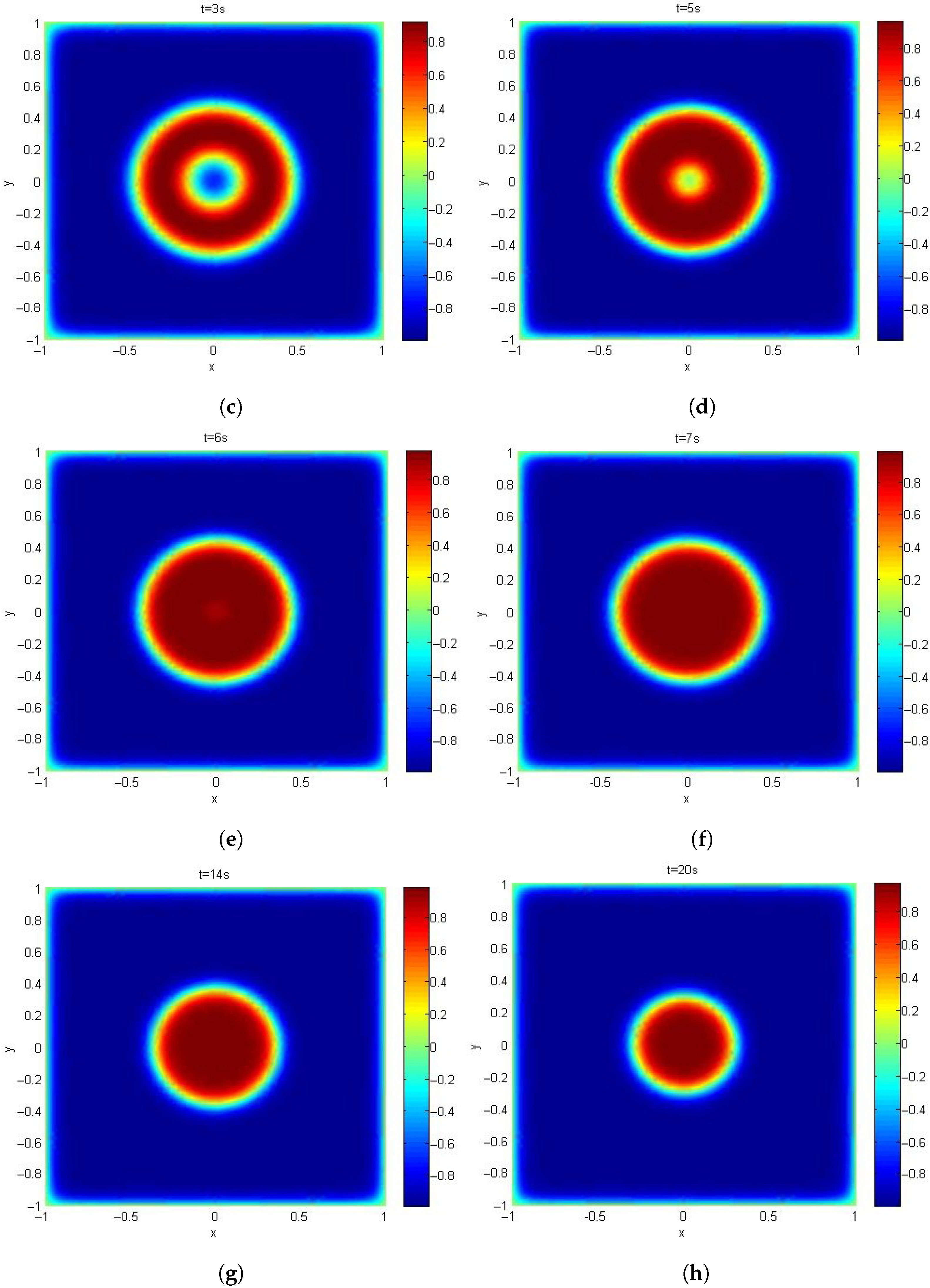1. Introduction
The main objectives of this article are to propose a finite element method and conduct its numerical analysis for the fractional Allen–Cahn equation with regularized logarithmic free energy:
which characterizes the coarsening dynamics with long-range interactions of a two-phase system in a phase field approach. This formulation extends classical phase field theories to nonlocal phenomena [
1,
2,
3,
4,
5,
6] while also enabling applications in biological systems [
7,
8], nuclear morphology [
9], and droplet dynamics [
10,
11]. Here,
as
is a bounded and convex domain with smooth boundary
and
serves as the diffusion coefficient. The unknown
—the non-conserved order parameter—quantifies the normalized atomic density difference between coexisting phases in the two-phase system. For instance,
corresponds to the pure phases A and B, respectively;
with
is the fractional Laplace operator; and
is the regularized logarithmic free energy functional, which is technically designed to effectively approximate the logarithmic potential
given by
with the absolute and critical temperatures
and
satisfying
In
Section 2, We shall give a detailed discussion on the properties of the fractional Laplace operator
and how the regularization removes the weak singularity of the logarithmic potential
at
The above system constitutes a natural generalization of the well-known and extensively studied Allen–Cahn equation with classical double-well potentials. More precisely, when an
system (
1a) reduces to the Allen–Cahn equation [
12,
13], and when
,
Using the Taylor expansion of
at
, the logarithmic free energy (
2) thus reduces to the classical double-well model in the form of a quartic polynomial, widely used in the literature.
However, the logarithmic potential was originally introduced to model the entropic contributions to free energy in thermodynamic systems [
12,
13,
14]. Its formulation preserves the underlying thermodynamics of phase separation more rigorously than polynomial approximations, which may not fully capture entropic effects in certain systems. Moreover, long-range interparticle interactions require nonlocal operators for physical accuracy [
15,
16,
17,
18,
19,
20], and the fractional Laplacian operator stands out as a favorable choice due to its role as a natural extension of the classical Laplacian and its retention of desirable properties of classical elliptic operators, such as self-adjointness and positivity. Motivated by these considerations, we aim to establish a computational framework for the fractional Allen–Cahn equation with a regularized logarithmic free energy, which simultaneously ensures thermodynamic consistency and accurately captures the dynamics of nonlocal interactions.
In the literature, numerical methods for the fractional Allen–Cahn equation have been extensively studied. Specifically, Zhai et al. [
21,
22] adopted the spectral method to develop an efficient algorithm, while Cui et al. [
23,
24] employed finite-difference-like schemes. For finite element simulations, relevant works can be found in [
2,
4,
25,
26]. It is worth noting that all these studies are based on the classical double-well potential. Unlike the extensive study on the solvability theory and the numerical simulations for the (fractional) Allen–Cahn equation with polynomial potential, there are few studies on the solvability theory of the fractional Allen–Cahn model with logarithmic potential, owing to the computing challenges from the nonlocality of the fractional Laplacian and the weak singularity of the logarithmic potential.
In this article, we propose a finite element method for (
1), following the idea of regularization [
27,
28], whereby weak singularities may be reduced and regularized potentials can successively approximate the logarithmic counterpart. We then prove the existence and uniqueness, the energy decay property, and the optimal convergence rate for the finite element solution, using the Brouwer fixed-point theorem. Numerical experiments were conducted to verify the theoretical findings and demonstrate our method’s better applicability compared to traditional numerical models.
The remainder of this article is organized as follows.
Section 2 reviews the basic properties of the fractional Laplacian and the regularized logarithmic potential.
Section 3 develops a fully discrete finite element scheme and establishes its solvability.
Section 4 provides a rigorous analysis of energy dissipation laws and convergence properties. Finally,
Section 5 presents numerical experiments demonstrating theoretical findings and investigating physical characteristics of the proposed framework.
2. Preliminaries
In this section, we shall review the essential properties for the fractional Laplacian operator
[
29,
30] and the regularization of the logarithmic potential (
2) [
27].
Assume that
as
is the Schwartz space consisting of all rapidly decaying functions. Let
be a fractional Laplacian operator of order
r defined as
, for
:
where
denotes the
-ball of
centered at
x, and
We understand that
reduces to the Laplacian operator
as
.
To establish the variational framework for model (
1), we shall define the fractional Sobolev space, which is closely related to the fractional Laplace operator
.
Definition 1 ([
29,
30]).
Let the space be endowed with its standard scalar productand the induced norm We define the fractional Sobolev space aswhich is endowed with the normFurthermore, the truncated Sobolev spaces over are defined bywith their norms and , which are the closed subspaces of and , respectively. Noting that the Hilbert triple [
29] (Formula (25))
with compact and densely defined canonical injections, and the extension operator of
to 0 outside
is a continuous mapping of
, we may represent the weak form of the fractional Laplacian operator
for
by
, for
:
Lemma 1 ([
29] Inequality (21)).
The Poincaré-type inequality holds, as follows:with C depending only on r, d, and Ω. Thus,defines an equivalent norm to in . Based on this framework, we test (
1a) by
and rewrite (
1) as the following Galerkin weak form: Find
such that
Here,
represents a class of continuous functions on
in the weak topology
of a normed space
Remark 1. As suggested in [29] (Section 4), the proof for the solvability of the Cahn–Hilliard equation did not rely on the coercivity of the double-well potential, and thus, their proof could also be extended to fractional Cahn–Hilliard equations with more general classes of potentials. Therefore, it is reasonable to assume that the fractional Allen–Cahn equation with regularized logarithmic potential Ψ admits the unique solution The logarithmic free energy functional
defined in (
2) requires regularization to address singularities near phase boundaries
while preserving thermodynamic consistency. Following the approach in [
27], we define the following regularized potential:
where
is a piecewise regularized term:
and
Let
,
, and
be the derivatives of
,
, and
, respectively. Through computation, we obtain
Obviously, the regularized potential
and its Fréchet derivative
are well defined for
Furthermore,
and
satisfy the following properties:
Lemma 2 ([
31]).
For fixed and constant , the following properties hold:- (i)
Strict monotonicity: , which implies that is strictly increasing on ;
- (ii)
Maximal monotonicity: is continuous and convex on , and thus, its Fréchet derivative is maximal monotonic, satisfying - (iii)
Lipschitz continuity: As a real-valued function, is Lipschitz continuous with constant , i.e., for any
3. Finite Element Procedure and Its Solvability
Based on the above fundamental knowledge and properties, a fully discrete finite element scheme for Equation (
1) is constructed in this section using the backward Euler method. Furthermore, by applying the Brouwer’s fixed-point theorem, the solvability of the discretized system is established.
First, we define spatial and temporal discretization. Let
denote a quasi-uniform polygonal partition of the domain
, where the mesh size is characterized by
. For each element
, let
denote the number of its interior vertices. The total number of vertices in the mesh is denoted by
. The temporal domain
is uniformly partitioned into
N subintervals
for
with nodes
, where the time step size is defined as
. Next, we define the finite element space
as
where
denotes the set of polynomial functions of degree at most
q on the element
Applying the backward Euler method to discretize the time derivative in (
5) and using the convex splitting scheme to deal with the regularized logarithmic potential term, we establish a fully discrete space–time Galerkin formulation of (
1). That is, for any test function
the discrete solution
satisfies
Here,
is the elliptic projection of
onto the finite element space
.
Let
be the basis function at the internal node
. Then, the linear finite element space
can be rewritten as
Consequently, the finite element solution
at the
n-th time step can be expressed as a linear combination of basis functions:
where
and
.
Substituting (
8) into the finite element scheme (
7), we obtain the following algebraic system:
where
is the unknown vector that needs to be solved. The mass matrix
H, defined by the entries
, is symmetric and positive definite. The stiffness matrix
, characterized by the fractional Laplacian inner product
, has the following computational form:
with the reduced integration domain as
Due to the coercive and symmetric properties of the
-inner product
, we can conclude that the stiffness matrix
is also symmetric and positive definite [
29]. Moreover, the nonlinear vector
satisfies the Lipschitz continuity condition, since its entries
induced by
are Lipschitz continuous.
Remark 2. In particular, in the one-dimensional case, the matrix admits an explicit expression under the piecewise linear finite element framework, as provided in [25] (Section 3). However, for higher-dimensional cases, due to the increased singularity of the kernel, numerical quadrature schemes are required to approximate the nonlocal interactions [26]. Then, we apply Brouwer’s fixed-point theorem to prove the existence and uniqueness of its numerical solutions to (
7), for which a supporting lemma is provided.
Lemma 3. For a given vector , let E and P be invertible matrices. Assume that is an matrix-valued function such that the norm of is Lipschitz continuous with constant . Then, the equationdefines a mapping . Furthermore, for a sufficiently small parameter , there exists a unique fixed point for the mapping . Here, is a spherical domain centered at with a radius of 1. Proof of Lemma 3. Due to the fact that
E is an invertible matrix, (
12) can be transformed into
Define the mapping
that satisfies (
13). Then, applying the Lipschitz continuity of
Q, we have
if
is small enough that
and we get
This indicates that
is a self-mapping from
to
. According to Brouwer’s fixed-point theorem [
32,
33], it can be deduced that there is at least one fixed point in
. Let
and
be fixed points. By substituting them into (
13) and combining the Lipschitz continuity of
Q and the boundedness of
and
P, we obtain
where
If
is sufficiently small such that
, we can conclude that
. As a result, the mapping
possesses a unique fixed point within the domain
. This completes the proof. □
Theorem 1. When is small enough, for each , there exists a unique solution satisfying the discrete scheme (9). Proof of Theorem 1. Given the symmetry and positive definiteness of the matrices H and , it is obvious that they are invertible. Furthermore, the matrix-valued function G exhibits Lipschitz continuity in its operator norm.
Therefore, by applying Lemma 3 on the discrete variational framework governed by (
9), we establish the existence and uniqueness of a fixed point for the nonlinear mapping
, thereby guaranteeing the well-posedness of the algebraic system (
9). This completes the proof. □
5. Numerical Experiments
In this section, we carry out three numerical experiments to test the accuracy and efficiency of the fully discrete finite element scheme (
7). The first experiment is a one-dimensional case designed to verify the theoretical convergence results. For the second and third experiments, we select initial conditions to investigate the phase separation phenomenon and energy dissipation law in the one- and two-dimensional cases. Moreover, in the second example, we illustrate two comparisons: (1) the differences in interface width between the fractional Allen–Cahn (FAC) equation and classical Allen–Cahn (AC) equation; and (2) the contrasting effects of the logarithmic potential and the polynomial potential on phase separation dynamics. All experiments are implemented on Matlab R2014a (MathWorks, Natick, MA, USA).
Example 1. Take , , , , and . Assume that the analytical solution iswith the left term f:Here, , which is as close as possible to . Table 1 presents the spatial errors and convergence orders for Example 1 (1D) with time step
. When
and
, the error orders for
are approximately 2, which are slightly higher than the theoretical convergence order
. Moreover, the orders of
are close to 1.9, consistent with the theoretical convergence order
.
Table 2 shows the temporal errors and convergence orders in Example 1 (1D). The results show that the convergence rates are almost 1 for
and
, which match with the theoretical order of the backward Euler scheme.
Example 2. Take , , , , and . Assume that the initial condition is Figure 1 shows the phase separation of the polynomial initial condition in Example 2 (1D) with
and
. It is obvious that as time increases, the mixed phases gradually separate and reach an equilibrium state.
As clearly shown in
Figure 2, the total energy decreases over time in Example 2 (1D) with
and
, which is in agreement with the theoretical energy decay property.
Figure 3 compares the equilibrium state of the FAC equation and AC equation in Example 2 (1D) at
with
and
. It is evident that the interface width exhibited by the FAC equation is narrower than that of the AC equation with the same parameter values.
Figure 4 shows the comparison of different fractional orders
,
, and
in Example 2 (1D) with
and
. The results indicate that as the fractional order
r increases, the interface width becomes larger at the equilibrium state.
Figure 5 presents a comparison among different diffusion coefficients (
, and
) in Example 2 (1D) with
and
. The results show that the interfacial width becomes broader as the coefficient
increases.
Figure 6 illustrates the phase separation process in FAC systems using a logarithmic potential (left) and a quartic polynomial potential (right) in Example 2 (1D) with
and
. The results demonstrate that as
, the logarithmic potential can be approximated by a quartic polynomial. Furthermore, the comparison of
Figure 6a,b reveals that systems governed by the logarithmic potential achieve better phase separation efficiency. This indicates that the logarithmic potential is not only a generalization of polynomial potentials; it plays a unique and indispensable role in computational modeling.
Example 3. Take , , , , and . Consider the following initial condition in Equation (43):Here, , , , , , and . This initial condition simulates a radially symmetric phase-separated target pattern, with its core-shell structure corresponding to the initial state of spinodal decomposition commonly observed in binary mixtures after quenching. Figure 7 shows the total energy of the coarsening processes in Example 3 (2D). The maximum diameter of the triangular elements is
, and the time step is
. It is obvious that the total energy is decreasing as time increases, which indicates that the finite element scheme obeys the physical property of the energy decay.
Figure 8 illustrates phase separation and interface coarsening phenomena in Example 3 (2D). The maximum diameter of the triangular elements is
, and the time step is
. The results show that, as time increases, the initially coexisting phases progressively separate into two pure phases, while the pure phase gradually coarsens. In this 2D case, the computation of
refers to reference [
26].
6. Conclusions
In this study, we develop a general framework for the
(
) fractional Allen–Cahn equation with a regularized logarithmic potential using
k-th-order finite element space for spatial approximation and backward Euler scheme for temporal discretization. The existence and uniqueness of the discrete solution are established using the Brouwer fixed-point theorem, while the energy decay property and optimal convergence estimates are proven. Numerical experiments demonstrate that the regularized model (Equation (
1)) may provide sharper interfaces and a more precise depiction of the coarsening process compared to both the classical Allen–Cahn equation and the double-well potential model.
While the dense matrix structure induced by the fractional Laplacian operator poses significant computational costs and storage challenges, efficient fast algorithms should be considered in future work, especially regarding comparisons of efficiency across different methods. Moreover, this numerical framework can be extended to the fractional Cahn–Hilliard equation with singular potentials, which is a meaningful research topic we are currently pursuing. Additionally, we will incorporate experimental parameters to conduct quantitative simulations of physical systems in subsequent work.

